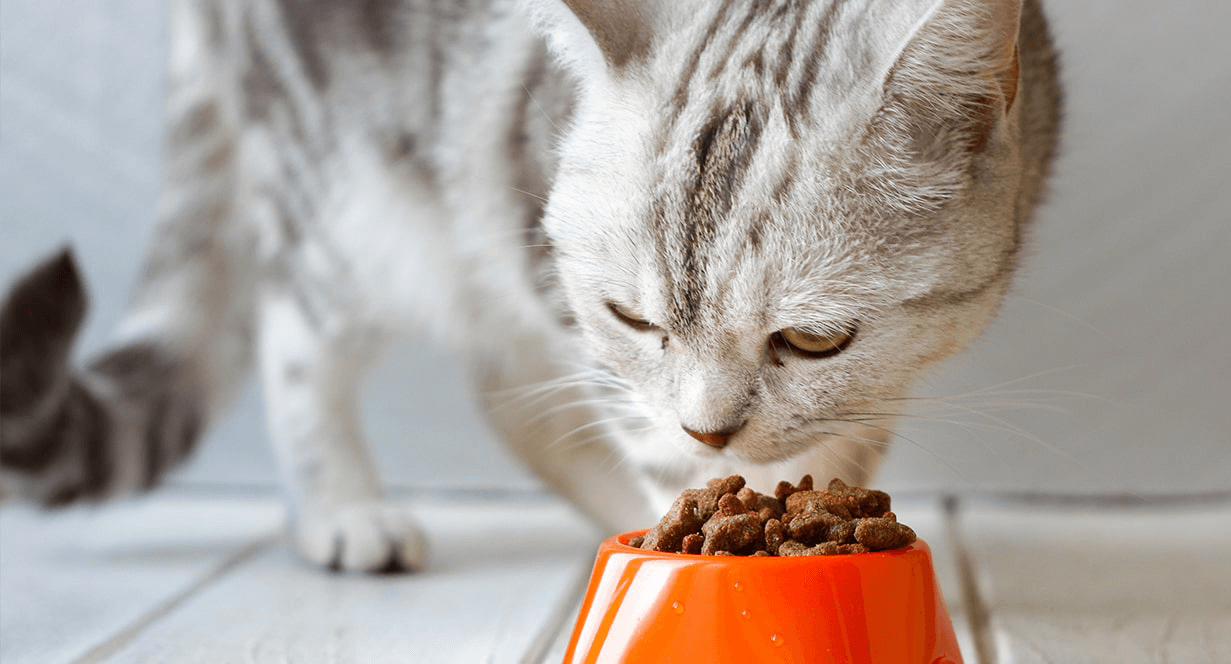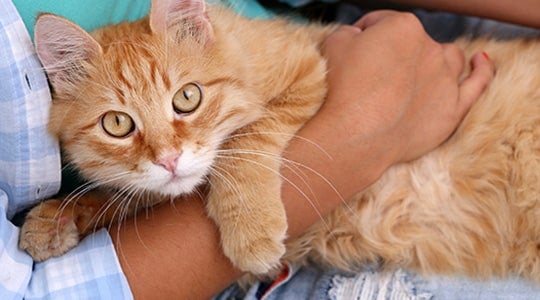

Your cat is one of a kind, so it stands to reason that you want to choose a cat food that accounts for their unique tastes, age, breed and health concerns. But with thousands of pet foods available, how do you pick the one that’s right for your cat?
First, it’s important to understand your cat’s nutritional needs. Then, you’ll need to think about your cat’s life stage, lifestyle and any health issues, and do a bit of research on cat food types, ingredients and cost. That may sound complicated, but we’ll make it easy for you — just keep reading.
Good nutrition is as important to your cat as it is to you — but their nutritional needs are quite different! Unlike humans, a cat needs a high-fat diet with less fiber. And even if you prefer a vegetarian diet, keep in mind that cats are carnivores. They need nutrients from animal protein and fat for optimal health, and they benefit from fiber for a healthy digestive tract and carbohydrates for energy.
Kittens, adult cats, nursing mothers and mature or senior cats are all examples of life stages, and each has different nutritional requirements. All cat foods should state which life stage they are recommended for — as an example, IAMS™ Proactive Health™ Mother and Kitten as well as IAMS™ Proactive Health™ Healthy Adult include the intended life stage right on the package.
Nutritional needs also vary depending on your cat’s lifestyle. A cat whose primary activity is guarding the couch doesn’t need as much energy as one who enjoys roaming outside.
.
Because cats need the nutrients found in animal sources, it’s best to pick a food in which a primary ingredient (one of the first ones listed) is an animal-based protein source such as chicken, lamb, fish, egg or one of their by-products. These ingredients contain all the essential amino acids your cat needs, including taurine, which isn’t found in a plant-based protein source. Foods that include a combination of carbohydrates in your cat’s diet, such as corn meal or barley and grain sorghum, ensure efficient absorption of nutrients and help maintain energy levels. And beet pulp is an excellent fiber source that promotes a healthy digestive tract.
For a soft, thick coat and healthy skin, your pet needs fatty acids like those found in vitamin-rich fish oils and quality fat sources such as chicken.
Cat food labels provide limited information on the nutritional value of your pet’s food because labeling regulations do not allow manufacturers to describe the quality of ingredients on the package. A reputable pet food manufacturer can explain how they evaluate and ensure the quality of their products.
When choosing cat food, the saying “You get what you pay for” definitely applies. A low price may indicate cheap ingredients or ingredients that change as manufacturer costs fluctuate. So while price is an important factor, it shouldn’t be the only one you consider.
Plus, many lower-priced products recommend higher daily portions to provide the same amount of nutrition found in a high-quality diet. To get a better idea of cost, it is the cost per feeding, not the total cost, that counts.
To figure out the cost per feeding for a cat food, divide the total cost by the number of days the product lasts. When compared closely, high-quality pet foods tend to come out on top, from both a nutritional and a cost standpoint.


Introducing a new cat into your home and life is a rewarding and fulfilling decision, one that requires some thought before you head to the shelter. So what should you consider before adopting a cat? Follow our tips to prepare for the best.
First, let’s explore some of the commitments you’ll need to make to ensure your new cat is content (and that you are, too!).
Make sure your home is cat-safe by eliminating or hiding away anything that could harm or poison your newbie. This includes:
You’ll need a cat bed or hideout, toys, scratching mats, a cat tree or climbing tower, food and water bowls, litter and boxes, and, of course, well-balanced, nutritious cat food. IAMS™ provides a wide range of tailored, nutritional cat food to promote the health of your new cat.
Plan to budget for an annual exam (older cats or those with special conditions may need more frequent visits), medication and parasite preventives. It’s smart to save for emergency care, too.
Providing daily play and exercise opportunities can keep your cat physically and psychologically healthy, and help strengthen your bond. Toys, feather wands and cat trees should be part of your regular rotation! And believe it or not, many cats can be trained to walk on a leash.
Not all cats are solitary or antisocial; however, they can become this way if they aren’t introduced properly to new experiences. Strange sounds, smells and even appliances in your home might make a new cat anxious, as can other family members and pets (more on this later). So be sure to help your new cat get accustomed to unfamiliar people, places and things, and reward and praise them when doing so.
Make sure you have the necessary box, scoop and other supplies to keep things tidy. If you have a multiple-cat household, provide one box per cat, plus one additional box, to help quell territorial issues.
Keep in mind that cats often live into their teens and maybe even a second decade if you’re lucky. Know that you’re adopting a true family member for the extent of their lifetime.
A cat match made in heaven starts by asking some questions about yourself.
If you are not home regularly or gone for extended amounts of time, a cat’s independent nature can be a great fit. If your life includes other people or pets, make sure their behaviors, personalities and lifestyles suit having a cat family member — both for their sake and the cat’s. Allergies can be a dealbreaker, so take note of anyone in your home with cat allergies and their or your willingness to take allergy medication, vacuum constantly and groom the cat regularly to alleviate symptoms.
Your home should also have the space for play and exercise and shouldn’t harbor anything dangerous to your cat.
Cats offer a variety of distinctive personality types, ranging from puppy-like cuddliness to feigned disinterest. Some cats are constantly on the go, exploring and poking into this and that, while others are certified nap ninjas. Vocally, they can be chatty catties or more taciturn souls. In short, you have a wide spectrum of personality types to choose from — which is what makes cats such fascinating and easy-to-love pets.
Kittens will need a lot of attention, direction and a fair amount of patience. Their size, energy and inquisitive nature means you’ll need to supervise them closely.
Adult cats often will settle more quickly into a routine once introduced to their new home. An older or senior adult cat may be even more comfortable interacting with children and furniture. And providing a real home for a cat in their golden years is a rewarding and noble gesture you can feel good about.
All cats shed. This will affect anyone with allergies and could also cause health issues for your cat, like hairballs or matting. Long-haired cats need to be brushed more regularly, and not all cats love this, so you may have to train yours to sit through this daily ritual.
There are several reasons adopting a cat from a shelter or rescue organization is preferable to buying. More effort goes into matchmaking when you adopt, because shelters and rescues generally have more information about their cats. Plus, adopting your cat from a shelter or a rescue actually helps two cats: the one you adopt and the homeless cat who takes your cat’s place.
In contrast, buying can be much more expensive than adopting, and the practice encourages cat mills and increases the number of pets who need homes.
At shelters you can often visit with more than one cat and breed. The screening process can be easier (many shelters allow you to take a cat home that day), and adoption fees can be lower than at a rescue. However, the vet services might not cover all that your cat needs.
Rescues have some advantages over shelters. They often know more about candidate cats because they may be placed in foster homes and even trained for a home. So you could adopt a cat that is already litterbox trained, socialized with other pets and with kids, trained to keep off furniture, etc.
Depending on the rescue’s screening process, you might have to make an appointment to see one cat at a time. While the screening might take longer, it’s designed to match you to the right cat. Adoption fees might be a little higher with a rescue, but they often cover more vet care, too.
While rescues and shelters have similar adoption processes, they do vary depending on the organization. But you can count on these basic steps:
Make sure to have a valid ID to verify age (most organizations require adopters be adults) and address. You might also need references, so it’s a good idea to email or call ahead of time and ask about the application and overall adoption process.
Some of the cat adoption questions you might be asked include:
They might also ask questions about your health, occupation and personal life to help match the right cat to the right parent.
A home and family meet-and-greet might be required to see how everyone, including other pets, gets along with your prospective new cat. And the organization will want to ensure your residence will be a comfortable and safe home.
As we mentioned, cat adoption costs can vary, with rescues often being higher than shelters. Fortunately, the adoption fee will take care of basic veterinary services you will need anyway, including vaccinations, spaying or neutering, and microchipping.
Adopting a new cat isn’t just rewarding — it can be life-changing. Taking stock of the commitments of cat ownership, and taking the time to find your perfect feline match, will help set you both up for years of joy.